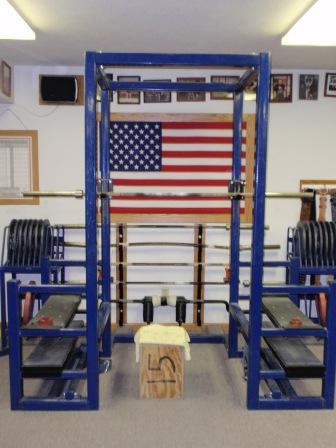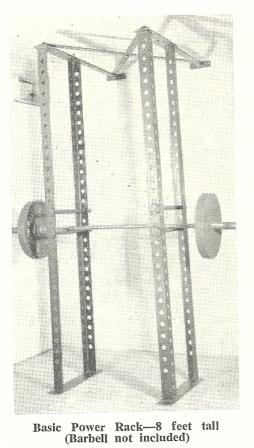A good POWER RACK is hard to find
by Al Myers

This is the custom-built Power Rack in the Dino Gym, which I made many years ago. It has many unique features (like hydraulic jacks attached to the bar hooks for easy adjustment of a loaded bar) that benefit lifters and lifting!!
I’ve spent a good part of my adult life in the gym training, and with that experience comes exposure to many different type of power racks. Some good, but most have deficiencies in my opinion. There always seems to be some feature that is less than optimal on each one I have used. But Power Racks (or often called Power Cages – same thing, different name) have come a long ways since the early York Cages or Iron Man Power Racks. I consider a good power rack as the SECOND MOST IMPORTANT piece of equipment in a gym (behind bars and plates). A good power rack is the centerpiece of any serious gym, and often the most used piece of equipment in a free weight based training facility. Up to 50% of my training time is spent in the “rack” each week doing a multitude of different lifts. Having a good power rack to fulfill your training objectives goes a LONG WAYS to making continued strength improvement. Today I’m going to go over power rack features that I feel are very important in having the ultimate power rack, from most important to least important.
1. Sturdy construction and Size
There are many racks on the market made out of lightweight tubing, with bolt-on construction. A Power Rack should be heavy duty and not “bouncing around” every time a squat is racked in it. A frame made out of at least 2.5″ 11 gauge square tubing is necessary. Also – the side frames should be welded and not bolted together. Most commercial racks that are sold will use bolt-on construction to minimize the shipping costs – but in turn will cause inherent weaknesses in the power rack. Bolts will loosen up with time, and bolted construction allows “wiggle room” in the joints. Depth of power racks is also important to give plenty of room for lifting. The depth of a power rack should be at least 36 inches. The power rack should be high enough to not interfere with any type of overhead lifting you want to do – but this is often limited by ceiling height.

Power Racks have come a long ways since this "top of the line" power rack advertised in a 1966 issue of Iron Man.
2. Bar Hooks (or J-hooks as they are normally called)
I think the bar hooks (which holds the bar in the power rack) either “makes or breaks” a good rack. They are the most functionally used piece of the Power Rack, and should be of the highest quality, yet often good racks have junky bar hooks. A bad bar hook will be an ongoing frustration and will soon completely overshadow all other aspects of your power rack. Most bar hooks are made by utilizing bending, which often gives an inconsistent product. Most bent- type bar hooks I’ve seen have a sloppy fit on the rack. The reason for this because of the bending a good consistent tolerance can’t be maintained – and thus manufacturers make them loose to insure that they will fit in all cases. I just hate bar hooks that “swing in the breeze” on a rack. Every time the bar is moved the bar hook will slide to the side. Bar hooks should also be of adequate length, but at the same time not too long as to catch the bar as a lifter comes up from a squat. Short bar hooks are a bigger problem. A bar hook should be of length to allow a lifter to rack the weight easily. Another important feature is NO SHARP EDGES. I have scars on both of my shoulders that occurred as the result of bar hook injuries in the gym. Both times I wasn’t paying attention and caught the edge of my shoulders on bar hooks attached to the front of the rack. Add in the number of times I’ve cut the outside of my palms from sharp edges on hooks as I was racking a heavy squat, and you can see why I think this is an important feature. Bar hooks should also be easy to adjust to different heights, and not require specialized wrenches or tools to do this.
3. Elevated bottom cross member
Most of the commercial power racks available DO NOT allow a wide based squatter to get proper foot placement. A floor cross member interferes with the feet when trying to take a wide stance squat (often limited to 43″ or 44″ at width). This problem is easily addressed by raising the bottom cross member up 12 inches. That’s it – but for some reason power racks often are not designed that way. A good power rack should allow for “sumo stance” lifting.
4. Multiple adjustments
A good power rack should allow for any spacing of the bar hooks or safety supports. I’ve seen some manufacturers go way overboard with the number of holes they place in their uprights (and make a holey looking rack, haha), but most have hole spacings that are too far apart, thus making it more difficult to get the correct setup for the hooks and supports. Most serious lifters like their bar height setting for unracking a bar down to an inch of being correct. I think anything over 2″ spacing is too much. But placing more holes in tubing is an expensive manufacturing cost – so this is often compromised in providing a top quality product.
5. Safety supports
A good power rack will have quality safety supports. Safety supports are the adjustable cross members that will catch the bar in case of a failed lift. Think of them as your safety net. They should adjust easily, yet be very sturdy and secure. Often you will see a rod inserted through the holes of the rack for this. That is a poor design in my book as no rod is going to stay straight after dropping a loaded bar on it. Some manufacturers have a pipe that you insert the rod through for the safety supports. Again that is a cheap poor solution to safety supports. Safety supports should be strong enough to lift off of – like doing rack pulls. For this they need to be well made. Having them lined with rubber to protect the bar is also a good idea, yet most all of them don’t have that. They should be easy to adjust to different height as well.
6. Able to take Add-ons
Add-ons for power racks are the new thing amongst the leaders of manufacturers of power racks. However, I prefer a power rack that “looks like a power rack” and not cluttered with unneccesary appendages hanging off it at all angles, but I know I’m in the minority on this. As for the add-ons I’m talking about here – chin up bars, plate storage, bar racks, band/chain peg attachments, land-mine attachments, chain/band storage, dip attachments, front safety supports, med ball bounce plates, etc. And there’s even more!!! Before long the power rack doesn’t even look like a power rack anymore. Gyms and training facilities like to keep a “clean house” and with all the new training devices being used nowadays, it is hard to find a place to store them so the solution seems to be to just hang them on the power rack. The important thing here is to have a power rack that has the capability to utilize whatever add-on YOU WANT.
I know I’ve covered a lot here – but Power Racks are something that I’m passionate about. If anyone ever wants to either discuss power racks, or has specific questions about them just drop me an email (amyers@usawa.com) . I’m always glad to hear from other power rack enthusiasts!